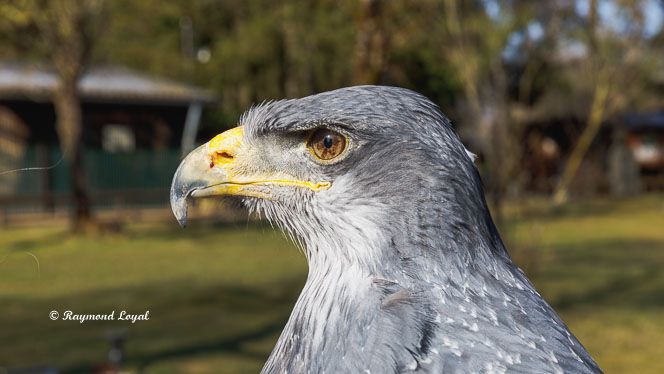Black-chested Buzzard-Eagle (Geranoaeetus melanoleucus)
The Black-chested Buzzard-eagle is a very large and bulky Buzzard. In fact it is the largest Buzzard of all buteonines because it really comes across in the size of an eagle. The name says it all. Other names attributed to this large buzzard are: Black-chested Buzzard, Black Buzzard-eagle, Grey Buzzard-eagle, Eagle Buzzard or Black-chested Eagle. Whatever name we may pick out of this list they all describe the uge dimensions of the buzzard.
In this article I tell you a lot of details on this species and also show some images. Although a pure South American native, this species can be seen in Europe in zoos and falconries where it is kept for dispaly and breeding programmes. Read more.


Description - Characteristics: Black-chested Buzzard-Eagle
Breeding – Clutch – Measurements – Habitat – Diet - Threats
Taxonomy:
Order: Accipitriformes
Family: Accipitridae
Genus: Buteoninae
Species: Black-chested Buzzard-Eagle
Scientific Name: Geranoaeetus melanoleucus Viellot 1819
Names and Synonyms of the Black-chested Buzzard-Eagle
Name in German: Blaubussard – Kordillierenadler - Aguja
Name in Czech: Káně orlí
Name in Slovak: Myšiak aguja
Name in Hungarian: óriásölyv
Name in Französisch: Buse aguia
Name in Spanish: Águila Mora
Name in Portuguese: Aguia-chilena
Name in Italian: Aquila poiana pettonero
Name in Niederländisch: Grijze Arendbuizerd
Name in Finnisch: Deguhaukka
Name in Schwedisch: Svartbröstad vråg
Name in Polnisch: Aguja wielka
Name in Russisch: Агуйа
Characteristics of the Black-chested Buzzard-Eagle
Distribution: Neotropical. Rare species. Local in Central America, northwest South America down south to Patagonia covering the entire Andean area. Not in dense forest. Small stretch along the Brazil east coast and in south Brazil and in the entire south American area.
Movements: Sedentary in breeding area. Juveniles are migratory after becoming independent.
Habitat: Thin dry woodland, espinal woodland, savannah, grassland, dunes, semi-desert scrub, monte desert, open hills; most common on steep and rocky uplands, broken mountain slopes with canyons and adjacent steppes Mostly settling at sealevels between 1,600 to 2,500 m, max. up to 3,500 m, in Venezuela up to 4,500 m and even higher.
Behaviour: Very good gliding abilities. Forages out of search flight by circling or by long sailing ransects, also hanging in wind and also actively hovering over ground and then dropping to ground. . Guter Gleit- und Segelflieger. Like other buzzards soaring high in thermals during noon.


Measurements
Size: 62-80 cm
Weight:
♂: ca. 1700 g
♀: ca. 2300 g
Wingspan: 149-180 cm
Breeding
Maturity: no recorded data.
Mating: lifelong monogamous breeding pair
Clutches per breeding season1 clutch
Breeding: West Mexico: from April, Februar bis April until end of June; earliest possible laying of eggs from February.
Nest: Large, bulky platform made of sticks; recorded continuous use of the nest over several years. Nest measuring 85 – 102 cm across; lined with dead and green leaves. Nest sits in tall trees, also on ledges and outcrops, also on cactus and power pylons.
Clutch: (1-) 2 (rarely 3) eggs
Laying Interval: 1 day.
Begin of incubating: Probably after the second egg.
Incubation: 30 days.
Fledging: fledging after 56-59 days. In Columbia fledged juveniles recorded at end of June.
Dependency: After fledging the juveniles will be cared for by parents for a period of up to 10 months, after that they are fully independent.


Miscellaneous
Food: Mostly smaller mammals, also birds, nestlings, snakes, lizards, carrion, insects. Forages in flight. Mammals make up c. 80% of all prey. The maximum weight of a single prey is roughly 2-3 kg. Prey: degus, rabbits, cavies, skunks, grey fox, even a Burrowing Owl was recorded
Longevity: In captivity Black-chested Buzzard-Eagles can reach an age of 42 years.
Mortality: no recorded data available.
Threats: Mammal predators and Eagles.

References
Brown, Leslie, Die Greifvögel - Ihre Biologie und Ökologie, Paul Parey Verlag Hamburg und Berlin, 1979
Ferguson-Lees, Jame; Christie, David, Raptors of the World - A Field Guide, Christopher Helm London, 2005, reprinted 2019
Grzimek, Bernhard et al (HG), Grzimeks Tierleben, Enzyklopädie des Tierreiches, Band VII , Vögel 1, Kindler Verlag AG Zürich, 1968
Schönberg, Horst, Falknerei - Der Leitfaden für Prüfung und Praxis, Verlag Peter N. Klüh Darmstadt, 3. durchgesehene Auflage 2009
Image Credits
all images by ©Raymond Loyal
